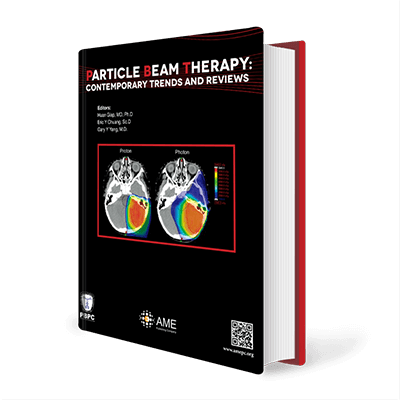
Particle Beam Therapy
| Editors: | Huan Giap; Eric Y Chuang; Gary Y Yang |
Publisher: AME Publishing Company (2014)
ISBN-13: 978-9881299741
Hardcover: 291 pages
Language: English
Particle Beam Therapy: contemporary trends and reviews addresses the importance of charged particle beam therapy. Charged particles with their favorable depth of dose distribution are ideal for treating tumors located inside the body.With all the potential advancements from physics and radiobiology, the field of charged particle beam therapy is still facing many challenges and is far from reaching its full capacity and application, especially how to improve patients' survival and 40 quality of life as well as to be cost effective.
Editors
| Huan Giap | Professor, Department of Radiation Medicine and Applied Sciences, University of California at San Diego Chief of GI, Lung, and Breast Service Director of Clinical Research, Scripps Proton Therapy Center, San Diego, CA 92121, USA |
| Eric Y Chuang | Professor and Director, Graduate Institute of Biomedical Electronics and Bioinformatics, National Taiwan University, Taipei, Taiwan |
| Gary Y. Yang | Professor and Dell E. Webb Chair in Radiation Medicine, Department of Radiation Medicine, Loma Linda University Medical Center, Loma Linda, CA 92350, USA |
Table of Content
1 Charged particle beam therapy: a new dawn for cancer treatment
Clinical
3 Historical perspective and evolution of charged particle beam therapy
13 Particle therapy for central nervous system tumors in pediatric and adult patients
26 Stereotactic radiosurgery with charged-particle beams: technique and clinical experience
40 Proton beam therapy for intracranial and skull base tumors
50 Boron neutron capture therapy for brain tumors
57 Proton therapy for head and neck cancer: current applications and future directions
66 Proton radiotherapy in the treatment of lung cancer
73 Proton therapy for gastrointestinal cancers
82 Proton therapy for hepatocellular carcinoma
89 Stereotactic body proton therapy for liver metastases
94 Proton therapy may allow for comprehensive elective nodal coverage for patients receiving neoadjuvant radiotherapy for localized pancreatic head cancers
100 Protons offer reduced bone marrow, small bowel, and urinary bladder exposure for patients receiving neoadjuvant radiotherapy for resectable rectal cancer
106 Rectal cancer: do protons have prospects?
108 Proton beam radiation therapy of prostate cancer - history, results, and future directions
119 Clinical trials for charged particle beam therapy
Physics and Biology
122 Emerging evidence for the role of an endorectal balloon in prostate radiation therapy
131 Surgical organ displacement: what is the best “materials and methods” for proton radiotherapy?
133 New developments in treatment planning and verification of particle beam therapy
145 Improving the precision and performance of proton pencil beam scanning
156 Proton therapy dose calculations on GPU: advances and challenges
166 Toward robust proton therapy planning and delivery
176 Comparison of tissue characterization curves for different CT scanners: implication in proton therapy treatmentplanning
187 Surgical organ displacement for proton radiotherapy
195 Gold nanoparticles in radiation research: potential applications for imaging and radiosensitization
207 Convergence of nanotechnology with radiation therapy—insights and implications for clinical translation
220 Nanoparticles in radiation therapy: a summary of various approaches to enhance radiosensitization in cancer
233 Role of p53 in regulating tissue response to radiation by mechanisms independent of apoptosis
243 Molecular mechanisms involved in tumor repopulation after radiotherapy
250 Cancer stem cells in glioma: challenges and opportunities
263 Normal tissue protection for improving radiotherapy: Where are the Gaps?


